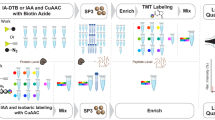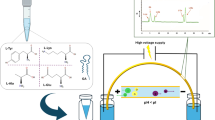Abstract
Alzheimer’s disease (AD) is the most common type of dementia, but early and accurate diagnosis remains challenging. Previously, a panel of cerebrospinal fluid (CSF) biomarker candidates distinguishing AD and non-AD CSF accurately (>90 %) was reported. Furthermore, a multiple reaction monitoring (MRM) assay based on nano liquid chromatography tandem mass spectrometry (nLC–MS/MS) was developed to help validate putative AD CSF biomarker candidates including proteins from the panel. Despite the good performance of the MRM assay, wide acceptance may be challenging because of limited availability of nLC–MS/MS systems in laboratories. Thus, here, a new MRM assay based on conventional LC–MS/MS is presented. This method monitors 16 peptides representing 16 (of 23) biomarker candidates that belonged to the previous AD CSF panel. A 30-times more concentrated sample than the sample used for the previous study was loaded onto a high capacity trap column, and all 16 MRM transitions showed good linearity (average R2 = 0.966), intra-day reproducibility (average coefficient of variance (CV) = 4.78 %), and inter-day reproducibility (average CV = 9.85 %). The present method has several advantages such as a shorter analysis time, no possibility of target variability, and no need for an internal standard.




Similar content being viewed by others
References
Abdi, F., J.F. Quinn, J. Jankovic, M. McIntosh, J.B. Leverenz, E. Peskind, R. Nixon, J. Nutt, K. Chung, and C. Zabetian. 2006. Detection of biomarkers with a multiplex quantitative proteomic platform in cerebrospinal fluid of patients with neurodegenerative disorders. Journal of Alzheimer’s Disease 9: 293–348.
Alzheimer’s Association. 2014 Alzheimer’s disease facts and figures. [Online] Available from http://www.alz.org/downloads/Facts_Figures_2014.pdf. Accessed 30 June 2015.
Anderson, L., and C.L. Hunter. 2006. Quantitative mass spectrometric multiple reaction monitoring assays for major plasma proteins. Molecular & Cellular Proteomics 5: 573–588.
Arnold, S.E., B.T. Hyman, J. Flory, A.R. Damaiso, and G.W. Van Hoesen. 1991. The topographical and neuroanatomical distribution of neurofibrillary tangles and neuritic plaques in the cerebral cortex of patients with Alzheimer’s disease. Cerebral cortex 1: 103–116.
Carrette, O., I. Demalte, A. Scherl, O. Yalkinoglu, G. Corthals, P. Burkhard, D.F. Hochstrasser, and J.C. Sanchez. 2003. A panel of cerebrospinal fluid potential biomarkers for the diagnosis of Alzheimer’s disease. Proteomics 3: 1486–1494.
Choi, Y.S., and T.D. Wood. 2007. Polyanilin-coated nanoelectrospray emitters treated with hydrophobic polymers at the tip. Rapid Communications in Mass Spectrometry 21: 2101–2108.
Choi, Y.S., L.H. Choe, and K.H. Lee. 2010. Recent cerebrospinal fluid biomarker studies of Alzheimer’s disease. Expert Review of Proteomics 7: 919–929.
Choi, Y.S., S. Hou, L.H. Choe, and K.H. Lee. 2013. Targeted human cerebrospinal fluid proteomics for the validation of multiple Alzheimer’s disease biomarker candidates. Journal of Chromatography B 930: 129–135.
Davidsson, P., A. Westman-Brinkmalm, C.L. Nilsson, M. Lindbjer, L. Paulson, N. Andreasen, M. Sjogren, and K. Blennow. 2002. Proteome analysis of cerebrospinal fluid proteins inAlzheimer patients. Neuroreport 13: 611–615.
Doody, R.S., J.C. Stevens, C. Beck, R.M. Dubinsky, J.A. Kaye, L. Gwyther, R.C. Mohs, L.J. Thal, P.J. Whitehouse, S.T. DeKosky, and J.L. Cummings. 2001. Practice parameter: management of dementia (an evidence-based review). Report of the Quality Standards Subcommittee of the American Academy of Neurology. Neurology 56: 1154–1166.
Eriksson, J., and D. Fenyo. 2007. Improving the success rate of proteome analysis by modeling protein-abundance distributions and experimental designs. Nature Biotechnology 25: 651–655.
Finehout, E.J., Z. Franck, L.H. Choe, N. Relkin, and K.H. Lee. 2007. Cerebrospinal fluid proteomic biomarkers for Alzheimer’s disease. Annals of Neurology 61: 120–129.
Gifford, D.R., and J.L. Cummings. 1999. Evaluating dementia screening tests. Neurology 52: 224–227.
Hu, Y., A. Hosseini, J.S.K. Kauwe, J. Gross, N.J. Cairns, A.M. Goate, A.M. Fagan, R.R. Townsend, and D.M. Holtzman. 2007. Identification and validation of novel CSF biomarkers for early stages of Alzheimer’s disease. Proteomics-Clinical Applications 1: 1373–1384.
Leuzy, A., S.F. Carter, K. Chiotis, O. Almkvist, A. Wall, and A. Nordberg. 2015. Concordance and diagnostic accuracy of [11C]PIB PET and cerebrospinal fluid biomarkers in a sample of patients with mild cognitive impairment and Alzheimer’s disease. Journal of Alzheimers Disease 45: 1077–1088.
Mares, J., P. Kanovsky, R. Herzig, D. Stejskal, J. Vavrouskova, P. Hlustik, H. Vranova, S. Burval, J. Zapletalova, V. Pidrman, R. Obereigneru, A. Suchy, J. Vesely, J. Podivinsky, and K. Urbanek. 2009. The assessment of beta amyloid, tau protein and cystatin C in the cerebrospinal fluid: laboratory markers of neurodegenerative diseases. Neurological Sciences 30: 1–7.
Noga, M., F. Sucharski, P. Suder, and J. Silberring. 2007. A practical guide to nano-LC troubleshooting. Journal of Separation Science 30: 2179–2189.
Pan, S., J. Rush, E.R. Peskind, D. Galasko, K. Chung, J. Quinn, J. Jankovic, J.B. Leverenz, C. Zabetian, C. Pan, Y. Wang, J.H. Oh, J. Gao, J. Zhang, T. Montine, and J. Zhang. 2008. Application of targeted quantitative proteomics analysis in human cerebrospinal fluid using a liquid chromatography matrix-assisted laser desorption/ionization time-of-flight tandem mass spectrometer (LC MALDI TOF/TOF) platform. Journal of Proteome Research 7: 720–730.
Pannee, J., E. Portelius, M. Oppermann, A. Atkins, M. Hornshaw, I. Zegers, P. Hojrup, L. Minthon, O. Hansson, H. Zetterberg, K. Blennow, and J. Gobom. 2013. A selected reaction monitoring (SRM)-based method for absolute quantification of Aβ38, Aβ40, and Aβ42 in cerebrospinal fluid of Alzheimer’s disease patients and healthy controls. Journal of Alzheimers Disease 33: 1021–1032.
Pes, O., and J. Preisler. 2010. Off-line coupling of microcolumn separations to desorption mass spectrometry. Journal of Chromatography A 1217: 3966–3977.
Rohlff, C. 2000. Proteomics in molecular medicine: Applications in central nervous systems disorders. Electrophoresis 21: 1227–1234.
Romeo, M.J., V. Espina, M. Lowenthal, B.H. Espina, E.F. Petricoin, and L.A. Liotta. 2005. CSF proteome: A protein repository for potential biomarker identification. Expert Review of Proteomics 2: 57–70.
Simonsen, A.H., J. McGuire, V.N. Podust, H. Davies, L. Minthon, I. Skoog, N. Andreasen, A. Wallin, G. Waldemar, and K. Blennow. 2008. Identification of a novel panel of cerebrospinal fluid biomarkers for Alzheimer’s disease. Neurobiology of Aging 29: 961–968.
Struyfs, H., B. Van Broeck, M. Timmers, E. Fransen, K. Sleegers, C. Van Broeckhoven, P.P. De Deyn, J.R. Streffer, M. Mercken, and S. Engelborghs. 2015. Diagnostic accuracy of cerebrospinal fluid amyloid-β isoforms for early and differential dementia diagnosis. Journal of Alzheimer’s Disease 45: 813–822.
Tao, D., G. Xhu, L. Sun, J. Ma, Z. Liang, W. Zhang, L. Zhang, and Y. Zhang. 2009. Serially coupled microcolumn reversed phase liquid chromatography for shotgun proteomic analysis. Proteomics 9: 2029–2036.
Wilm, M., and M. Mann. 1996. Analytical properties of the nanoelectrospray ion source. Analytical Chemistry 68: 1–8.
Zhang, J., I. Sokal, E.R. Peskind, J.F. Quinn, J. Jakovic, C. Kenney, K.A. Chung, S.P. Millard, J.G. Nutt, and T.J. Montine. 2008. CSF Multianalyte profile distinguishes Alzheimer and Parkinson diseases. American Journal of Clinical Pathology 129: 526–529.
Acknowledgments
We gratefully acknowledge the National Institutes of Health (R01MH59926, 2P20RR016472, 5P30RR031160), the New York State Office of Science, Technology, and Academic Research, and the Institute for the Study of Aging for support of this work.
Author information
Authors and Affiliations
Corresponding author
Ethics declarations
Conflict of Interest
None
Rights and permissions
About this article
Cite this article
Choi, Y.S., Lee, K.H. Multiple reaction monitoring assay based on conventional liquid chromatography and electrospray ionization for simultaneous monitoring of multiple cerebrospinal fluid biomarker candidates for Alzheimer’s disease. Arch. Pharm. Res. 39, 390–397 (2016). https://doi.org/10.1007/s12272-015-0663-y
Received:
Accepted:
Published:
Issue Date:
DOI: https://doi.org/10.1007/s12272-015-0663-y




